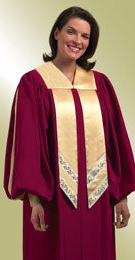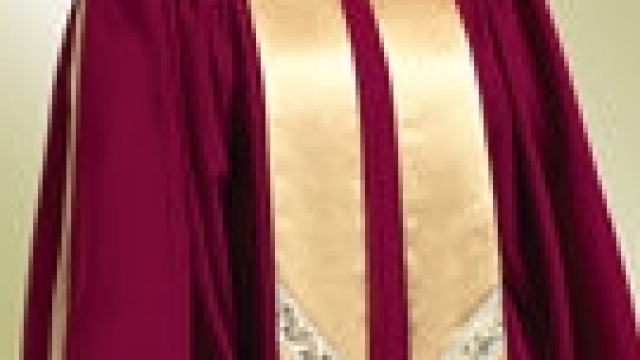
The world of choir robes is a truly enchanting one. These elegant garments, often overlooked, play a vital role in creating a sense of unity and harmony among singers. From their rich history to their diverse styles, choir robes have become an iconic symbol of choral performances, instilling a sense of tradition and reverence. In this article, we delve into the captivating world of choir robes, exploring their significance and the impact they have on the overall performance. Join us as we unravel the story behind these stunning garments and discover the magical allure they bring to the choral stage.
History of Choir Robes
Choir robes have a rich history that dates back centuries. These garments, worn by vocal ensembles during performances and religious ceremonies, have evolved over time to become an integral part of choral traditions.
During the early days of Christianity, choir members wore simple white garments to symbolize purity and unity. As the church gained prominence, the robes began to incorporate more intricate designs and colors, reflecting the hierarchy within the choir and the importance of music in religious rituals.
In the medieval period, choir robes became more distinct, with different styles and colors indicating the rank and role of each singer. Bishops and clerics often wore elaborate robes adorned with ornate embroideries and precious materials, while other choir members dressed in simpler yet still elegant attire.
The Renaissance era brought further changes to choir robes, as artistic and cultural developments influenced their design. Choir members donned robes with voluminous sleeves, stylish cuts, and luxurious fabrics, reflecting the opulence of the time. This period also marked the introduction of symbolic elements, such as embroidered motifs representing religious symbols and musical instruments.
Throughout history, choir robes have continued to evolve, adapting to the changing times while still honoring their traditional roots. Today, modern choirs embrace a wide range of robe styles, from traditional robe designs to more contemporary interpretations, all of which contribute to the enchanting world of choral performances.
Significance and Symbolism of Choir Robes
Choir robes hold great significance within the realm of choral performances. Beyond their practical purpose of providing a cohesive and uniform appearance for choir members, these robes also carry deep symbolism that adds to the enchantment of the musical experience.
Firstly, choir robes serve as a visual representation of unity and harmony. When a choir dons their robes, they become part of a collective entity, transcending their individuality for the sake of creating beautiful music together. The uniformity of the robes signifies the harmonious collaboration of voices, reminding both performers and audiences of the power of unity in artistic expression.
Additionally, choir robes have historically been associated with tradition and reverence. As singers step onto the stage or into the sanctuary, adorned in their robes, they tap into a long-standing heritage of choral performances spanning centuries. This connection to the past evokes a sense of respect and admiration for the art form, further enhancing the enchantment for both performers and spectators.
Moreover, choir robes often incorporate distinct colors that carry symbolic meaning. For instance, white robes can represent purity and spiritual enlightenment. Red robes may signify passion and energy, while black robes can evoke a sense of formality and solemnity. These colors not only add visual allure but also contribute to the emotional impact of the music, enhancing the overall experience for both performers and listeners.
In conclusion, choir robes hold multiple layers of significance and symbolism within the choral world. From promoting unity and harmony among performers to evoking a sense of tradition and reverence, these robes play an integral role in creating an enchanting and captivating musical atmosphere. By visually representing the collective nature of choral performances and incorporating symbolism through colors, choir robes contribute to the overall magic and allure of the choir experience.
Contemporary Trends in Choir Robes
Choir robes have come a long way in the world of fashion. With changing times and evolving tastes, contemporary trends in choir robes have introduced fresh styles, colors, and designs that add a touch of modernity to traditional ensembles.
Sleek and Streamlined Silhouettes: In recent years, there has been a shift towards more streamlined silhouettes in choir robes. Traditional voluminous designs have given way to sleeker and more fitted styles that flatter the wearer’s body shape. These modern silhouettes not only enhance the overall aesthetic appeal but also allow for ease of movement during performances.
Choir Robes For KidsVibrant Colors and Patterns: Gone are the days of solely relying on black and white robes. Contemporary choir robes are now available in a myriad of vibrant colors and patterns. Choirs often opt for shades that reflect their unique identities or incorporate their organizations’ logos. Bold geometric patterns and intricate motifs have also found their way into choir robe designs, adding a captivating visual element to performances.
Material Innovations: The choice of fabric plays a significant role in defining the look and feel of choir robes. Contemporary trends have witnessed an integration of innovative materials, such as lightweight synthetics and breathable fabrics, which ensure comfort and flexibility for choir members. These materials not only offer practical advantages but also contribute to a more contemporary and fresh appearance.
As choirs continue to amalgamate tradition with contemporary influences, the evolution of choir robes remains an ongoing process. These trends reflect a desire to embrace modernity while upholding the timeless elegance of choir performances.


